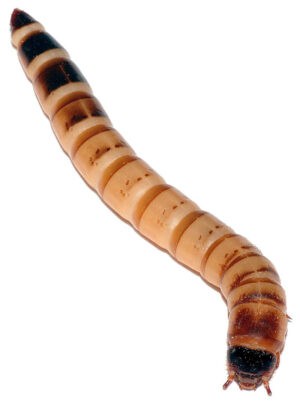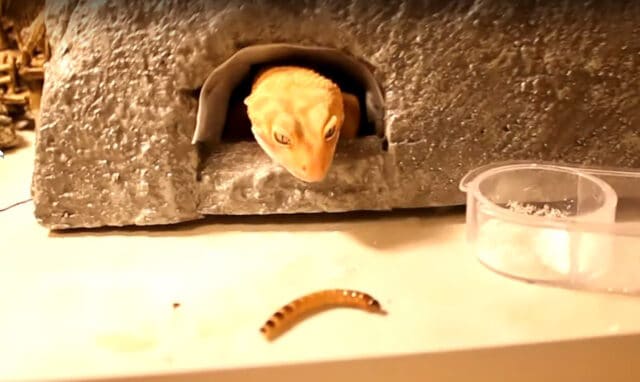Yes, leopard geckos can eat superworms, but they should be offered as occasional treats and not as a primary food source. Superworms, which are the larvae of darkling beetles, are rich in nutrients and protein. However, due to their high fat and phosphorus content, it’s essential to moderate their intake.
Serving these worms as an infrequent snack can provide your gecko with a delightful variation in their diet and offer some benefits when given alongside other calcium-rich feeder insects.
Can Leopard Geckos Eat Superworms?
Certainly, leopard geckos can consume superworms, but it’s crucial to treat these worms as an occasional delicacy rather than a regular meal. Superworms, being larvae of the darkling beetle, come packed with a host of nutrients beneficial for your pet.
However, their elevated fat and phosphorus levels necessitate careful consideration when incorporating them into your gecko’s diet. It’s recommended to balance their intake with other nutrient-rich insects to ensure a wholesome and varied diet for your leopard gecko. There is such a thing as overfeeding when it comes to superworms.
What is a Superworm?

Superworms are not just any ordinary worm; they are the larvae of darkling beetles. Often used as feeder insects, they are a popular choice for many reptile enthusiasts, especially those who care for leopard geckos and bearded dragons. Their distinct look and movement can offer a stimulating and engaging treat for these reptiles.
Now, while superworms are undoubtedly nutritious, boasting a rich protein content, there’s a catch. They also come with a high fat and phosphorus content, which can be a concern if offered too frequently. But, when fed as occasional treats, these worms can be a delightful addition, offering extra nutrients that can benefit the health of your pet reptile.
Benefits of Superworms for Leopard Geckos
When it comes to providing a treat for leopard geckos, superworms bring several benefits to the table. Firstly, their high protein content can serve as a valuable supplement, aiding in muscle development and overall health for the gecko.
Beyond just the protein, superworms also possess hydration properties. This aspect is vital as proper hydration is key to ensuring a healthy shedding process and maintaining overall skin health for geckos.
But it’s not just about the nutrition. The act of hunting superworms offers leopard geckos mental stimulation, giving them a break from their routine and sparking their natural hunting instincts. This interactive feeding can be both entertaining and beneficial for your pet, as it encourages exercise and engagement.
Nutrition of a Superworm Diet
Understanding the nutritional profile of superworms is crucial for any reptile enthusiast aiming to provide the best for their pet. While superworms can be a tantalizing treat for leopard geckos, diving deep into their nutritional content will help shed light on how often and in what quantities they should be fed.
Nutritional Content of Superworms
Superworms, at first glance, might seem like just wiggly treats, but they pack a surprising nutritional punch. Here’s a breakdown of what’s inside:
| Nutrient | Content |
|---|---|
| Moisture | Approx. 58% |
| Protein | Approx. 17% |
| Fat | Approx. 18% |
| Fiber | Approx. 3% |
| Calcium | 177 mg/kg |
| Phosphorus | 2,370 mg/kg |
The numbers speak for themselves. With a notable protein content, superworms can support muscle growth and tissue repair in leopard geckos. Their moisture level also aids in keeping the reptile hydrated.
However, one cannot overlook the high fat content in superworms. While fat is essential for energy, the percentage in superworms emphasizes the importance of moderation. Given their fat-rich profile, they are best suited as treats rather than staples in a gecko’s daily diet.
Calcium to Phosphorus Ratio in Superworms
When discussing reptile nutrition, particularly for leopard geckos, the calcium to phosphorus ratio stands out as a critical consideration. Balancing these two minerals is essential for a gecko’s overall health. Let’s break down the numbers for superworms:
| Mineral | Content (mg/kg) |
|---|---|
| Calcium | 177 |
| Phosphorus | 2,370 |
Analyzing the table, superworms have a calcium to phosphorus ratio of roughly 1:13.4. This indicates that phosphorus content significantly outweighs the calcium. So, why is this balance vital? An appropriate calcium to phosphorus ratio in a leopard gecko’s diet ensures proper bone development and metabolic functions.
An imbalance, especially with higher phosphorus levels like in superworms, can bind with calcium and lead to potential health risks.
One of the most pressing concerns arising from this imbalance is metabolic bone disease (MBD). MBD manifests as weak bones, deformities, and can be life-threatening if not addressed.
Extra Nutrients in Superworms
Superworms are more than just an occasional treat; they’re nutrient powerhouses. Packed with essential amino acids, these wriggly wonders serve as building blocks for protein synthesis, supporting growth and tissue repair in leopard geckos. But that’s not all. Superworms are a source of various vitamins and minerals that contribute to their overall nutritional appeal.
| Nutrient Type | Examples |
|---|---|
| Essential Amino Acids | Lysine, Methionine, Threonine |
| Vitamins | B-complex, E, D |
| Minerals | Phosphorus, Calcium, Magnesium, Iron, Zinc, Copper |
Delving deeper, minerals like calcium and phosphorus are fundamental for bone health, while elements like magnesium, iron, zinc, and copper play roles in metabolic processes, blood formation, and immune system support. Coupled with a mix of vitamins that facilitate various bodily functions, the nutrient composition of superworms accentuates their value in a leopard gecko’s diet.
Popular Feeder Insects for Leopard Geckos
When it comes to providing a varied and nutritionally balanced diet for leopard geckos, several feeder insects come to the fore. These insects, each boasting distinct nutritional profiles, can be integrated into a gecko’s diet either as staple feeders or occasional treats. The key is to understand their nutrient content, ensuring that the diet remains comprehensive and caters to the gecko’s diverse needs.
| Feeder Insect | Protein Content | Moisture Content | Fat Level |
|---|---|---|---|
| Crickets | High | Moderate | Low |
| Dubia Roaches | High | Moderate | Moderate |
| Phoenix Worms | Moderate | High | Low |
| Mealworms | Moderate | Low | Moderate |
| Silkworms | High | High | Low |
Starting with crickets, they’re a staple in the leopard gecko community, celebrated for their high protein content and relative ease of acquisition.
Dubia roaches, too, are rich in protein and are becoming increasingly popular, especially given their longevity and low odor.
Phoenix worms, with their high moisture content, are great for hydration and are often used as occasional treats.
Mealworms, though moderate in their protein content, are widely used due to their availability, but their fat content makes it essential to feed them in moderation.
Lastly, silkworms, packed with protein and moisture, are nutritious treats that can add variety to a leopard gecko’s diet.
Offered as a treat, even the wax moth can be a good option for a leopard gecko.
Safety Considerations
When it comes to feeding leopard geckos, ensuring their safety and well-being is paramount. While various feeder insects offer nutritional benefits, there are also potential risks and precautions that need to be addressed.
Digestive Issues with Leopard Geckos and Superworms
One of the concerns when feeding leopard geckos with superworms revolves around potential digestive issues. Superworms, given their somewhat chitinous exterior, can pose a risk of impaction if consumed in large quantities or if the gecko is not provided with appropriate conditions for digestion.
Impaction is a condition where the gecko’s digestive tract becomes blocked, which can be detrimental to their health. To avoid such complications, it’s crucial to monitor the quantity of superworms being fed, ensuring it remains within a reasonable limit.
Providing the gecko with an appropriate heat source facilitates proper digestion, breaking down the chitinous matter effectively.
Metabolic Bone Disease Risk with Leopard Geckos and Superworms
A significant health concern for leopard geckos is metabolic bone disease (MBD), a condition that can be exacerbated by certain dietary choices.
Feeding leopard geckos with superworms poses an MBD risk due to the insect’s nutritional makeup. Superworms inherently have high phosphorus content and are relatively low in calcium. This imbalance can be problematic because leopard geckos, like many reptiles, require a specific calcium to phosphorus ratio to maintain strong bones and overall health.
When the phosphorus content in their diet consistently outweighs the calcium content, it hinders calcium absorption, potentially leading to MBD. Other contributing factors to this disease can include improper UVB lighting, which aids in calcium metabolism, or feeding superworms excessively without balancing them with calcium-rich foods.
Fatty Insects and Healthy Weight of Leopard Geckos
Leopard geckos, like all animals, require a balanced diet to maintain an optimal weight and overall good health. Part of achieving this balance involves understanding the nutritional value of various feeder insects and how they impact the weight and health of the gecko.
Fatty insects, in particular, play a crucial role in this equation. While they can be a valuable source of energy and nutrients, excessive consumption or reliance on these insects can lead to weight gain and associated health issues.
Gut-Loading
Gut-loading is a strategic technique employed by reptile enthusiasts to maximize the nutritional value of feeder insects before they are offered to pets like leopard geckos.
Essentially, the process involves feeding the superworms a highly nutritious diet for a specific timeframe before they are given to the geckos. This ensures that the superworms are filled with beneficial nutrients, which are then passed on to the gecko when consumed.
The primary benefit of gut-loading is the enhanced nutritional value it imparts to the feeder insects. For example, a superworm that has been gut-loaded will have more vitamins, minerals, and other essential nutrients than one that hasn’t been. This makes them an even more valuable food source for leopard geckos, providing them with a more balanced meal.
To effectively gut-load superworms, it’s recommended to feed them a diet rich in leafy greens, fruits, and other nutrient-dense foods for about 24 to 48 hours prior to offering them to the gecko. By doing so, the superworms absorb and store these nutrients, effectively acting as a vessel to transport these beneficial elements directly to the leopard gecko’s diet.
Occasional Treats vs. Constant Feeding of Superworms
For many reptile enthusiasts, understanding the distinction between offering occasional treats and constant feeding is vital. When it comes to leopard geckos, this distinction is particularly crucial with superworms. While superworms pack a nutritional punch and can be an exciting treat for leopard geckos, they should be given in moderation.
Feeding superworms consistently and in large amounts can lead to health concerns. These worms, as nutritious as they are, have a high-fat content. Overfeeding can result in obesity and associated health issues in geckos. Moreover, the unbalanced calcium to phosphorus ratio in superworms can pose risks if they become the primary food source.
